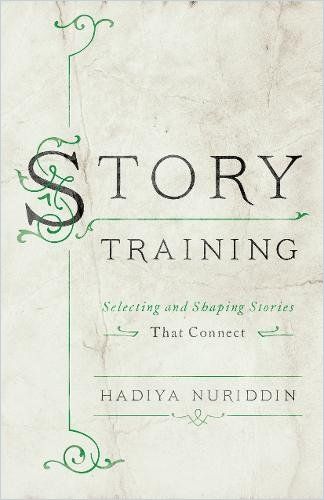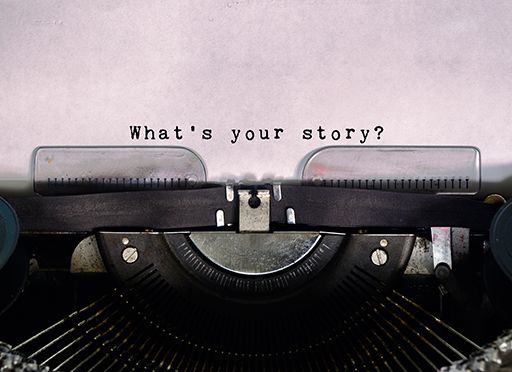“Mapped Perfection Is Often Not What Learners Want.”

Hadiya, stories are fundamental to how we think, learn and make sense of the world, you write in StoryTraining. Storytelling has been present in every age of human history and every civilization and culture. So how is it that in 2022 we still need to remember the value of stories – especially in business?
Hadiya Nuriddin: Stories expose our vulnerability. That is why personal storytelling is a great way to make professional training experiential and memorable. Expressing a story that grips people – in a way in which the content is meaningful – ensures people feel understood. Yet, many people are apprehensive about getting in front of a group of people and telling a story about themselves that may leave them open to judgment. In the business world, most people prefer to talk about their successes instead of their setbacks and lessons learned. The problem is that you get nothing out of success stories alone.
Why is that?
Many professionals think telling their story is about how great they are and what they’ve accomplished. But the real story begins before that. It’s how you got to that point of success. You need to share with others to engage them: What point were you at before? I always tell people that the story is not on the coast; it’s in the ocean. So, let’s dive back into that ocean and tell me what you did and why you did it – and what got you to a certain point.
Sharing your true story helps create an environment for your audience to feel comfortable telling their stories or reflecting on their lives.
Hadiya Nuriddin
And sometimes, that’s a real challenge for people.

What can people do about it?
When telling a story in a leadership or a learning context, think “headlight, not spotlight.” Instead of just letting the light shine on you and bringing attention to yourself in a story, think about the stories that can shine a light forward and lead the way for others. This technique also allows people who are reluctant to tell their own story: It’s less about you and more about you helping other people move forward.
How does this reflect in a story’s general structure for professional training?
Stories always come with events and change. Events are the things that happen. You can’t get away from what happens in professional or private life – be it obstacles, losses or big wins. But as they occur in a story, it’s important to share the change that came with these events. So whatever structure you apply should always be focused on events, change and transformation. Ideally, focus on the significant shift you reveal in the middle of your overall training story, like in the typical story arc, and the climax.
Take-Aways:
- In times of hybrid or virtual training, gripping storytelling becomes increasingly important.
- Building a story-driven learning path that also allows for the necessary short deep dives on specific topics is the supreme discipline of new training formats.
- The best training stories are composed of events and associated change – like classic heroic sagas.
- Coaches and trainers who are overwhelmed with the new hybrid situation should shamelessly pick up tricks from their favorite entertainers.
A climax is one thing, but a story only really sticks in the listener’s mind if it touches or appeals to something beyond that.
Exactly. When you tell a story about your life, people aren’t hearing the actual story. What they’re doing is filtering what you are saying through their own experience. So, there’s an inevitable surrender when it comes to storytelling: As soon as you let this come out of your mouth, it doesn’t belong to you alone anymore. From here, you create a story with your audience because they are creating their narrative around what you’re saying, connecting it to their values and their own experience. That’s where performance comes in, and your passion will come through – and it’s typically the most passionate storytellers that people actively listen to.
What sets them apart?
It’s their ability to divorce the idea of “this is about me” from creating a unique holistic experience for the people in the room. So that listeners can connect, tap into their values and what’s important to them in their own experience. That’s the purpose of telling a story – not the mere rattling off of best practices that supposedly work in every context peppered with short anecdotes around appealing industry heroes.
Right. But what about “people in the room,” as you said: For the past two years, training sessions have moved more and more into the virtual realm – has this made it more difficult or easier to reach people with good stories?
I did a lot of speaking in rooms before this, so in my mind, I still see them in a room. (Laughs.) The hardest thing for me is not getting the reaction you typically get, even when we went back to rooms for a while (with a mask on). All the years you told jokes and saw people sort of laugh, you know, you realized that they were not falling about laughing, just smirking a bit. These days, you can’t even see that slight smile. But, honestly, we as trainers are currently facing the same problems that other industries have solved. TV and Hollywood solved it already. They already know what to do. And we sit there like, “Gee. It’s just so confusing. I don’t know how to be interesting in front of the camera without a live audience.” But:
Whole industries are based on you being interesting in front of a camera! Look that up and see how you can learn from experienced entertainers – be it comedians, late-night talk masters or sports commentators. It’s just up to us to figure out how to apply what other industries are doing to what we’re doing.
Hadiya Nuriddin
That’s valuable advice for trainers. But more and more L&D professionals have to produce less content themselves and curate more third-party content instead to keep learners engaged – and that’s why storytelling became crucial. Is that right?
I think so, because I see all learning experiences as the story falling into a narrative arc. We are here in a space where the learners in front of us don’t know something – and we facilitate a narrative learning journey to get there, where they know something. It’s all about creating this experience: They should come out on the other side with some change, ideally a shift in performance. So when I start a blended experience, I must visualize how it falls on that story arc. The way you design it should be plotted along that path. Stories are carriers, and you are hired to fill up those carriers. How you fill them up, and with which media elements – videos, courses, texts, games – depends on what you have access to and find illuminating regarding the topic. And remember:
Story-arc-based learning journeys resonate better with learners than simply providing a load of individual how-to elements.
Hadiya Nuriddin
So, stories can serve as bridges between learning elements. What about substories around the individual components? I mean: How much mediation is enough? When does it become too much?
One of the challenges in L&D is the desire to curate and string together various elements. Yet, there’s also the desire to be able to pluck out one experience – and consume it by itself. Storytelling sometimes does not lend itself to that flexibility. If you’re trying to create a narrative arc that flows through the full experience, you can’t just pick up chapter three and have it make sense without the context provided in chapters one and two. Usually, there is a reason that chapter three is chapter three and not chapter one. Learners may miss the essential information shared before. Or they might not get the bigger picture that makes chapter three so valuable. As a learning experience designer, you must stay true to the bigger picture while ensuring learners can get the information they need when they need it.
Do you have to choose between one of the two options? Or is there a middle ground?
Whoever spans a story arc from A to Z can certainly set individual signposts on the way, where people can then also take a side turn. Those who do not want to travel the whole route may still want to pick a subtopic in a course or video. Well executed, these signposts and their substories make certain sense as separate items, but they should make even more sense in the flow of the overarching story.
Laying out the path becomes more important in the new virtual learning context. Storytelling helps with that.
Hadiya Nuriddin
At the same time, however, mapped perfection is often not what learners want.
Why is that?
Thankfully, there is a story that is useful in that regard. (Laughs.) When I finish training, there usually is a person in the room that I call the “slow packer.” After a couple of hours, most people are done – “OK, thank you, bye.” But you have at least one person slowly packing their bags, you know, slowly moving. And clearly, this person is waiting for the room to clear so they can ask you a question that they were too nervous to ask in front of everyone. Or they just wanted a more personalized answer. But they’re stalling for a reason. They have a particular problem they’re dealing with that wasn’t directly addressed in the class content. They may then say, for example, “Look, I just got promoted above my peers, and I don’t believe that my peers are respecting me now. I mean, I used to be their co-worker….”
They tell their story.
Yes. They say, “Now I’m their leader, and I don’t feel like they’re treating me the way I want them to treat me. So how do I handle a situation like that?” An instructor may now want to go back to the content and say, “Remember chapter three when we talked about conflicts?” But the person still looks at you. Next try: “OK, remember chapter eight where we talked about communication styles?” And they still just look at you. It becomes clear that that’s not what this person wants. They do not want a walk through the content. That’s not what they’re saying. They’re saying, “Do you understand what I’m going through?” The content is not addressing the betrayal that this person feels when they expected their team to be happy for them. They feel hurt. They don’t care about “communication styles” and “leadership.” They want to know how to stop this feeling. And so that’s when you listen to their story and ask appropriate questions when they’re stuck. And then they begin to probe a little bit, and they may talk about hurt and betrayal.
So, what you’re saying is that beyond the sophisticated story path made of content, what matters most is picking up the stories of the people themselves?
Exactly. And in that case, the facilitator does not have to tell a story that matches precisely with what was shared. You must interact and think, when was that time when you experienced that type of hurt, where you experienced that type of betrayal before? And how did you get over it? So, I told that slow packer a story about an experience I had: When I started teaching instructional design, I spent more time trying to make people laugh than teach. I saw my sense of humor as a strength. They may have laughed, but they also gave me very low ratings as an instructor. I too felt a little betrayed. So, I tried everything, but nothing worked. I soon realized that this experience belongs to the learners, not me. I was only focusing on myself. I realized that I should focus less on being the entertainer I thought they wanted and instead be the instructor they deserved. After that, my scores went up and we all had a much better experience.
So, what did the slow packer get from that story?
The truth in that story is: This is not about you. It’s about your colleagues and their careers. This is about you leading them, not about how they look at you and how they feel about you and all of that. Instead of being the friend you think they want, be the leader they deserve. So:
When you’re sharing your story with the learner, make sure that the story takes them through some progression, like in every hero story that takes hero and audience alike from a perfectly ordinary environment, which is then shaken, through setbacks and trials passed, to the climax – a significant change. This will get them going on their own stories.
Hadiya Nuriddin
You mentioned the hero story as a good blueprint for compelling training stories. What other techniques do you use to keep learners engaged?
Build suspense! For example, tell the end first. As Alfred Hitchcock said, you must let the viewer know there is a bomb in the room because, “There is no terror in the bang, only in the anticipation of it.” Another way to get them into a story or keep them engaged is to ask questions: Have you ever been in this situation? How did you handle it? Let them reflect and consider, “Yeah, I have been in that situation.” And then, after listening to their answers, you tell your story as a possibly surprising new approach that they hadn’t thought of before but to which they can now compare their answers.
How about humor? As you said, it’s not for everyone, and in a business context, it’s sometimes a tricky thing.
I like most humorous stories, and using humor, I think, plays a significant role in connecting with your audience. Often, the comedic side also fits the overarching setting of an underdog story – a variation on the hero story. You know, someone who didn’t think they would meet expectations, but ultimately, they did. Of course, the same applies to “fish out of water” stories that are unlikely to initially turn out on a positive note but then take a surprising – and often funny – turn. But it’s important to tap into those that resonate most with you.
What story blueprint resonates most with you?
One thing that I’ve always liked was dropping people into the narrative without a back story. You know, movies opening with a heist, where you first must figure out if the bad guys, in the beginning, will be the bad guys at the end? That’s what it’s like in real life, isn’t it? No stranger on the street will ever introduce themselves to you by initially telling their whole backstory. But parts of it always shine through in their interactions with you and everyone else – and as we learned, good stories are all about such connecting interactions.
About the Author
Hadiya Nuriddin is a learning strategist, instructional designer and owner of Duets Learning, an organizational learning design and development firm that provides technical and professional development courses.










